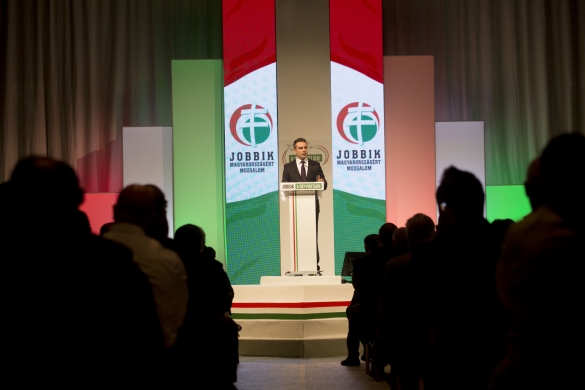Politicon.co
The curious case of the Hungarian right
On 8 April 2018, parliamentary election is to take place in Hungary. Though the victory of the ruling Fidesz led by Prime Minister Victor Orban is all but sealed, probably the most important thing about this election is the rise of Jobbik as a key opposition force in Hungary and a broader story about these two parties that may have big implications for many European countries that are now facing an unprecedented rise of right-wing populism, heavily laden with illiberal, xenophobic and even extremist undertones. To examine this story, we should trace the evolution of both Fidesz and Jobbik.
Hungary’s ruling party emerged in the midst of rapid demise of socialism in the late 1980s and initially constituted a party oriented toward the young people, espousing, contrary to the mainstream of the day, libertarian-progressive views. It was .jpg) marked then by strong condemnation of the socialist period of the Hungarian history, especially the tragic events of 1956. It gradually rose to prominence during the 1990s as a right-wing alternative to the social democrats who had formed the government in the first post-socialist years, and came first at the 1998 parliamentary election, when its young leader Victor Orban became Prime Minister for the first time. It was not distinguished for any particular Euroscepticism at the time and it was quite natural for the period when the majority of Hungarians were enthusiastic supporters of European integration. Then Fidesz lost in 2002 and went into opposition for 8 years.
marked then by strong condemnation of the socialist period of the Hungarian history, especially the tragic events of 1956. It gradually rose to prominence during the 1990s as a right-wing alternative to the social democrats who had formed the government in the first post-socialist years, and came first at the 1998 parliamentary election, when its young leader Victor Orban became Prime Minister for the first time. It was not distinguished for any particular Euroscepticism at the time and it was quite natural for the period when the majority of Hungarians were enthusiastic supporters of European integration. Then Fidesz lost in 2002 and went into opposition for 8 years.
Things started to change with Hungary’s long-awaited assent to the European Union in 2004. A lot of the institutional problems were revealed then, and predominantly positive views of Brussels among the Hungarians started to wean off. The 2008 crisis hit Hungary, laden with a significant foreign debt, quite hard, and the prospect of default was real. Against this background, Orban’s Fidesz considerably changed its rhetoric to become much more critical of the European bureaucracy, blaming it in the economic hardships the country had to endure. He also started to cater for conservative, predominantly small-town and rural people voters predisposed to more Eurosceptic and nationalistic views. This strategy helped Orban to win the 2010 election and form a government. Unlike many of the politicians who used populist rhetoric with electoral purpose, he held true to the spirit of his campaign; the Fidesz government soon got known for an obstinate position vis-à-vis many European initiatives, it passed laws de-facto curbing the freedom of press (with a visible desire to weaken liberal media), and interfering into the functioning of the courts. It is symptomatic that during Orban’s first term, the Fidesz spokespersons preferred to explain these policies with the alleged need to get rid of the remnants of communism, the cause the would-be prime minister preached a couple of decades before, at the dawn of his career.
However, at the same time another political force started to rise in Hungary: the extravagant far-right Jobbik, some of whose ideas were terrifyingly akin to radical and irrational nationalism that swept Europe in the 1930s. Unlike pragmatically populist Fidesz, Jobbik put forward a program based on archaic ideas, a radical version of paleoconservatism, at the time unprecedented for the European politics. The party organized “torch marches” characteristic for the interwar fascists, claimed that Jewish influence threatens Hungary’s Christian culture and openly called for discrimination of Roma people, hence championing the idea of ethnicity-based state. Jobbik’s leader, Gabor Vona, supported the printing of radical-right literature and consistently tried to cast doubt on the official history of Holocaust. With such a programme the party garnered around 16% of the popular vote at the 2010 elections and 20.5% in 2014, turning into the second biggest opposition party in Hungary.

But the 2015 immigration crisis bore unexpected consequences for the Hungarian politics. Riding on the wave of popular unwillingness to accept many thousands of mostly Muslim refugees arriving in Europe from the Middle East and Africa, Orban put himself in opposition to the EU plans to secure their settlement in all the member-states. It was then that his nationalistic politics reached new levels. While the right all over Europe was critical of the accommodating attitude towards refugees and claimed that they represented a threat to the European values and way of life, Hungarian Prime Minister hastened to self-proclaim “a defender of the Christian civilization undermined by the hordes of barbarians”, pitting himself against the liberal Eurobureaucrats who wished to destroy it. The official rhetoric started to explicitly refer to Hungary as a country first and foremost for ethnic Hungarians; xenophobia started to take ugly forms, for example, a police recruitment announcement called for “border hunters” implying to refugees trying to cross the border illegally. The government’s ambition was not constrained by national borders; Orban admittedly wants to turn Budapest into a hub for the radical right from all over Europe, while the ideas of “Great Hungary” (a historic Hungarian territory that included territories of present-day Romania, Slovakia, Serbia and Croatia) are experiencing revival. Finally, he has never disguised his sympathies for Russia’s authoritarian leader Vladimir Putin, once famously praising his success in “building an illiberal democracy”. Though half-heartedly joining the EU sanctions against Russia, Orban never misses an opportunity to emphasize special understanding between his and Russian governments.
In a word, during its second term the Fidesz government adopted a lot of features of the original Jobbik programme. But what about Jobbik itself? It could have easily faded into insignificance, as it has happened with the British UKIP after the Brexit vote, when its fringe position turned into the Conservative mainstream. However, the Hungarian alt-right surprised everyone once again, moving towards the “respectable” end of the right spectrum. First of all, the party dropped its blatant anti-Semitic and anti-Roma sentiments; in December 2016, Vona even sent the Hanookah greeting to the Jewish community. The party that once burned EU flags, has recently launched a European political programme that included a proposal to deepen integration in several fields and create a “European wage union”. Jobbik has also launched a “Western opening” to improve its relations with Western European countries and the United States. It now explicitly targets the traditional conservative and even some left-wing voters long disenchanted with the pro-European, liberal Social democrats. What is maybe even more important, the party has promoted itself as a harsh critic of the Fidesz policies, claiming that Victor Orban established a crony regime and is a cynical power maximizer without any genuine ideological commitment. Though Jobbik has not been admitted to the far-right group of the European Parliament (ENF) due to its toxic reputation, it now seems that the party has become less radical than many of the ENF members.
But what does it signify for the Hungarian and, to take a broader view, European politics? Of course, shifts in party ideologies have always taken place, but they usually took place much more slowly and in a less radical fashion. For example, the British Labour party turned from a classic worker party to a more post-modern liberal centrist one; but the process took decades and was caused by a gradual change in the social fabric and the long-term decline of British industry and, subsequently, working class. Some parties of the right had to assume more liberal positions on social issues as the public consensus on them shifted. However, it has been long assumed that the range within which positions can shift, is limited by considerations of ideological acceptability. “Toxic” movements of the far right and far left were usually excluded from this range and tended to remain within their own confines. Hence, the swift tactical shift of Jobbik attests to the erosion of these limits: the territory of the admissible is enhancing. Taking into account that Hungary has long been one of the most nationalistic countries in the EU, this could be a local phenomenon, but the wider European events say the opposite. The far-right has been triumphant in Poland and Austria, still more countries in the Central and Eastern Europe are governed by populists, while the latest Italian election ended with the triumph of the both of them. The case of Italy, where the government has not been formed yet and complicated negotiations go on, may be illustrative of where this trend would go further. What kind of far-right ideas would be on the agenda of a new government? In Hungary, we face a governing party that ruthlessly maximizes its electoral appeal in order to entrench its rule, and an opposition party that endeavours to wash out an uncomfortable legacy to become a common right party. However, in the long term this would be another blow to the system of ideological parties on which the European politics of a post-war era had been based.
References:
- Strickland, P. (2017) "How is Hungary's far-right changing?" Al Jazeera, 12 December 2017, https://www.aljazeera.com/news/2017/12/hungary-changing-171209110936676.html
- Zuroff, E. (2010) "Jobbik holds key to war criminal's fate" The Guardian, 9 April 2010, https://www.theguardian.com/commentisfree/2010/Zuroapr/09/jobbik-hungary-election-nazi-war-criminal
- Pirro, A. (2015) "The Populist Radical Right in Central and Eastern Europe: ideology, impact, and electoral performance" New York, 2015
- https://books.google.az/books?id=dEnLCQAAQBAJ&pg=PA149&lpg=PA149&dq=jobbik+evolution&source=bl&ots=Ua7zP35j6x&sig=z-SvGrchwBu_utK4GX14BCWyRXA&hl=ru&sa=X&ved=0ahUKEwjd_MeGhqXaAhUE8ywKHZIbBYkQ6AEITTAG#v=onepage&q=jobbik%20evolution&f=false
- "Europe's Rising Far Right: A Guide to the Most Prominent Parties" The New York Times, 4 December 2016 https://www.nytimes.com/interactive/2016/world/europe/europe-far-right-political-parties-listy.html
- Schaeffer, C. (2017) "How Hungary Became a Heaven for the Alt-Right" The Atlantic, 28 May 2017 https://www.theatlantic.com/international/archive/2017/05/how-hungary-became-a-haven-for-the-alt-right/527178/
- Kreko, P. (2017) "Hungary's far right? No longer the fringe" Hate Speech International, 8 March 2017, https://www.hate-speech.org/hungarys-far-right-no-longer-the-fringe/
- Dunai, M. (2018) "Hungary's Jobbik eyes election gains after ditching far-right views" Reuters, 22 March 2018, https://www.reuters.com/article/us-hungary-election-jobbik/hungarys-jobbik-eyes-election-gains-after-ditching-far-right-views-idUSKBN1GY2BT
- Bayer, L. (2017) "Trading places on the Hungarian Right" Politico, 14 August 2017, https://www.politico.eu/article/hugary-right-wing-trading-places-fidesz-jobbik/
![]()
- TOPICS :
- Domestic affairs
- Society
- REGIONS :
- Eastern Europe
